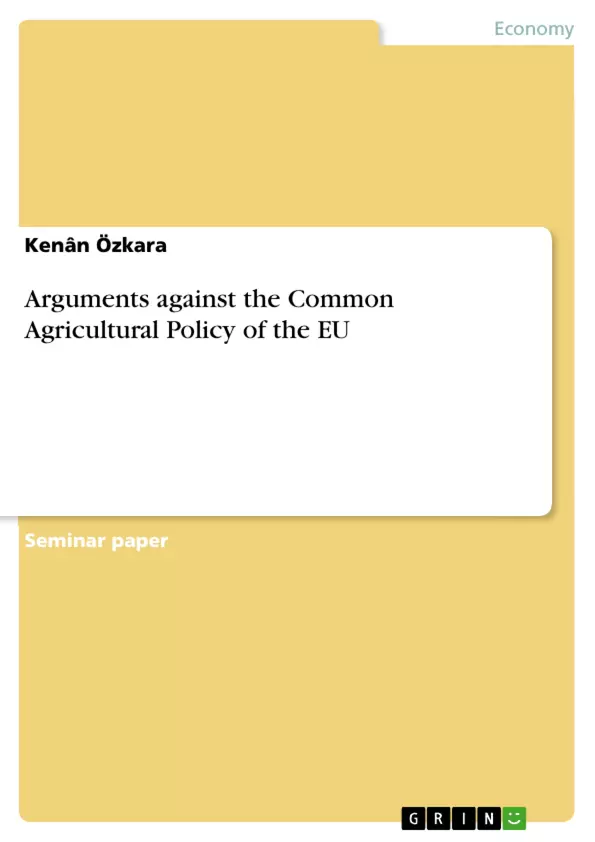Executive Summary
Initiated in 1962, the Common Agricultural Policy (CAP) is a system of agricultural subsidies. These subsidies work by guaranteeing a minimum price to producers, by deficiency payments or by direct income payments. The purpose of this paper is to question this policy by analyzing several impacts. As a result, we come to following main findings: The CAP causes budget troubles and costly disposal problems. Although agriculture is a declining sector that provides only about 4% of European jobs and 2% of European GDP, it is still provided with 46% of the EU budget in 2005. Furthermore, it is financed at the expense of consumers and taxpayers.
The EU export subsidies and the dumping cause worldwide distortions in the agricultural sector. Moreover, CAP policy makers use misleading justifications of their practices. Although the CAP is often promoted as helping small family farms, the largest part of it goes to huge commercial corporations and to some royal families. The distribution is unequal to the degree that 20 % of the farms (i.e. the largest farms) get 80 % of the benefits. The smallest farms (40 % of the total number) share only 8 %. As such, small family farms receive subsidies of quite an insignificant nature.
The CAP has encouraged the industrialization of agriculture, giving rise to factory farming practices and widespread animal suffering. The problem was that industrial farming led to more intensive use of land and chemicals.
Former reforms caused the EU to proceed from price supports to direct income subsidies. Thus, the CAP could be gradually improved, but today there still remain a lot of problems inherent, that allow to question the “raison d’être” of the CAP. [...]
Inhaltsverzeichnis (Table of Contents)
- 1. Introduction
- 2. The CAP and its impact
- 2.1. Methods of support
- 2.2. Budget troubles and "food mountains"
- 2.3. Dumping - "Everything but EU farms"
- 2.4. Unequal distribution of benefits
- 2.5. Environmental damages
- 3. Reforms
- 4. Evaluation of today's CAP
- 4.1. Instruments of the CAP
- 4.2. Budget troubles and "food mountains"
- 4.3. Dumping
- 4.4. Unequal distribution of benefits
- 4.5. Environmental damages
Zielsetzung und Themenschwerpunkte (Objectives and Key Themes)
This paper examines the Common Agricultural Policy (CAP), a system of agricultural subsidies implemented in the European Union in 1962. The paper analyzes the policy's impact, exploring its strengths and weaknesses, particularly focusing on its financial, social, and environmental implications. Key themes of the paper include: * **Budgetary implications:** The paper investigates the CAP's financial burden on the EU budget, highlighting the allocation of a significant portion of funds to agriculture while questioning its efficiency. * **World market distortions:** The paper examines the effects of EU export subsidies and dumping on the global agricultural market, analyzing their consequences for producers and consumers worldwide. * **Distribution of benefits:** The paper analyzes the distribution of CAP benefits among European farmers, particularly emphasizing the disparity between large and small farms. * **Environmental impact:** The paper explores the environmental consequences of the CAP, highlighting the relationship between industrial farming practices and environmental degradation. * **Reforms and challenges:** The paper examines past and ongoing reforms of the CAP and discusses the challenges in ensuring its effectiveness and sustainability.Zusammenfassung der Kapitel (Chapter Summaries)
* **Chapter 1: Introduction:** This chapter provides an overview of the Common Agricultural Policy (CAP) and its intended objectives. It highlights the conflicting nature of these objectives and introduces the structure of the paper, outlining the subsequent chapters. * **Chapter 2: The CAP and its impact:** This chapter delves into the functioning of the CAP and its various methods of supporting farmers. It analyzes the policy's negative consequences, including budgetary issues, world market distortions, unequal distribution of benefits, and environmental impacts. * **Chapter 3: Reforms:** This chapter examines the reforms implemented in the CAP, outlining the shift from price supports to direct income subsidies.Schlüsselwörter (Keywords)
This paper focuses on the Common Agricultural Policy (CAP), agricultural subsidies, budgetary implications, world market distortions, unequal distribution of benefits, environmental impact, reforms, and challenges.- Quote paper
- International Economics M.A. Kenân Özkara (Author), 2005, Arguments against the Common Agricultural Policy of the EU, Munich, GRIN Verlag, https://www.grin.com/document/53638



